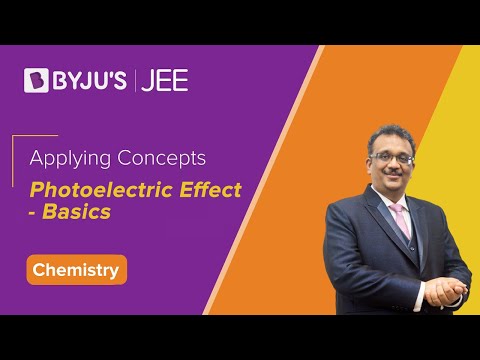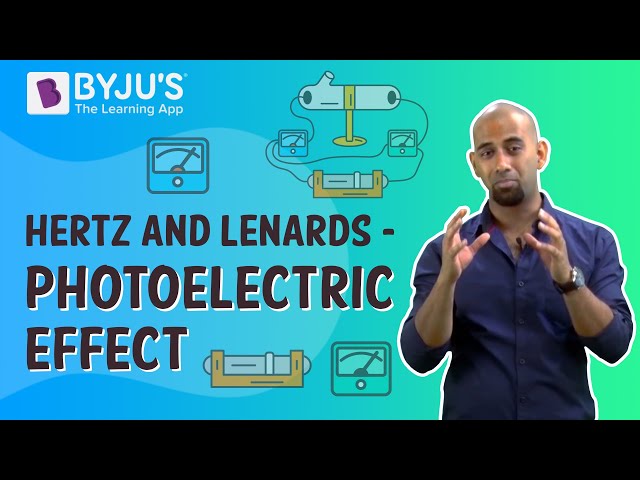The phenomenon of the photoelectric effect was discovered by Heinrich Hertz in the year 1887. When he experimented on electromagnetic waves, he observed a high voltage spark in the cathode ray tube when the cathode was illuminated with ultraviolet light. He did not investigate his observations in detail. In the year 1888, Hertz experiment was followed up by Hallwachs. He exposed a leaf electroscope to ultraviolet light and observed that the negatively charged zinc plate lost its charge, and the positively charged plate became more positive. He also observed that a neutral zinc plate acquired a positive charge. From his observations, he concluded that negatively charged electrons are emitted during the process. This phenomenon of emission of electrons from the metal plates when electromagnetic radiation of suitable frequency is incident on the metal plate is called the photoelectric effect.
Download JEE Advanced Previous Year Questions with Solutions on Photoelectric effect PDF
Question 1)If the mass of the particle is m = 1.0 x 10-30 kg and a = 6.6 nm, the energy of the particle in its ground state is closest to :
(A) 0.8 meV
(B) 8 meV
(C) 80 meV
(D) 800 meV
Answer: (B) 8 meV
Solution:
According to the model energy in nth state is given by n2h2/8ma2
Question 2) The speed of the particle, that can take discrete values, is proportional to
(A) n-3/2
(B) n-1
(C) n1/2
(D) n
Answer: (D) n
Solution:
The de Broglie wavelength,
λ = h/mv —–(1)
We also know, nλ = 2πa
⇒ λ = 2πa/n ——(2)
From equation (1) and (2) we get
h/mv = 2πa/n
⇒ v ∝ n
Velocity is proportional to the number of loops
Question 3) An α–particle and a proton are accelerated from rest by a potential difference of 100 V. After this, their de Broglie wavelengths are λα and λp, respectively. The ratio λp/λα, to the nearest integer is?
Answer: 3
Solution:
λ = h/p
Momentum in terms of kinetic energy
p = √2mK.E
= √2meV
λ = h/√2qeV
⇒ λp = h/√2mpepVp
⇒ λα = h/√2mαeαVα
Since, eα = 2ep
mα = 4mp
λα = h/√2(4mp)(2ep)Vα
= h/√16mpepVα
≈3
Question 4) A silver sphere of radius 1 cm and work function 4.7 eV is suspended from an insulating thread in free space. It is under continuous illumination of 200 nm wavelength light. As photoelectrons are emitted, the sphere gets charged and acquires a potential. The maximum number of photoelectrons emitted from the sphere is A x 102 (where 1 < A < 10). The value of ‘Z’ is?
Answer: 7
Solution:
R = 1 cm
f = 4.7 cm
hc/λ = Φ + eV0
eV0 = (hc/λ) – Φ
= (1240/200) – 4.7
= 6.2 – 4.7 = 1.5 eV
V0 = 1.5 V
We know, V0 = ne/4πε0r
n = 4πε0rV/e
= 1.5 x 10-2/(9 x 109 x 1.6 x 10-19)
= 1.2 x 107
Therefore the value of z is 7
Question 5) The work functions of silver and sodium are 4.6 eV and 2.3 eV, respectively. The ratio of the slope of the stopping potential versus frequency plot for Silver to that of Sodium is.
Answer: 1
Solution:
hv = Φ + eV0
(h/e)v = (Φ/e) + V0
V0 = (h/e)v – (Φ/e)
Comparing it with equation y = mx + c
⇒ Slope , m = h/e
Therefore, (Slope)Ag/(Slope)N = (h/e)/(h/e)
= 1
Question 6) A metal plate of area 1 x 10-4 m2 is illuminated by a radiation of intensity 16mW/m2. The word function of the metal is 5 eV. The energy of the incident photon is 10eV and only 10% of it produces photoelectrons. The number of emitted photoelectrons per second and their maximum energy, respectively will be [1 eV = 1.6 x 10-19 J]
(A) 1014 and 10 eV
(B) 1012 and 5 eV
(C) 1011 and 5 eV
(D) 1010 and 5 eV
Answer: (C) 1011 and 5 eV
Solution:
K.E = 10eV – 5eV = 5eV
Intensity, I = nE/At
n = number of photoelectrons
⇒ 16 x 10-3 = (n/t) x (10 x 1.6 x 10-19)/10-4
⇒ (n/t) = 1012
So, effective number of photoelectrons ejected per unit time = 1012 x 10/100
= 1011
Question 7) An electron beam is accelerated by a potential difference V to hit a metallic target to produce X-rays. It produces continuous as well as characteristic X-rays. If λmin is the smallest possible wavelength of X-ray in the spectrum, the variation of log λmin with log V is correctly represented in

Answer: (C)
Solution:
In X-ray tube, λmin = hc/eV
In λmin = In (hc/eV) – InV
Clearly, log λmin versus log V slope is negative, hence option (C) is the correct depiction.
Question 8)Match List -I (Fundamental Experiment) with List – II(its conclusion) and select the correct option from the choices given below the list:
| List – 1 | List- 2 |
| A. Frank – Hertz Experiment | (i) Particle Nature of Light |
| B. Photoelectric experiment | (ii) Discrete energy levels of the atom |
| C. Davison – Germer experiment | (iii) Wave nature of electron |
| (iv) Structure of atom |
(a) (A) – (ii); (B) – (i); (C) – (iii)
(b) (A) – (iv); (B) – (iii); (C) – (ii)
(c) (A) – (i); (B) – (iv); (C) – (iii)
(d) (A) – (ii); (B) – (iv); (C) – (iii)
Answer: (a) (A) – (ii); (B) – (i); (C) – (iii)
Solution:
Frank – Hertz Experiment – Discrete energy levels of the atom
Photoelectric experiment – Particle Nature of Light
Davison – Germer experiment – Wave nature of electron
Question 9) When the wavelength of radiation falling on a metal is changed from 500 nm to 200 nm, the maximum kinetic energy of the photoelectrons becomes three times larger. The work function of the metal is close to
(A) 0.81 eV
(B) 1.02 eV
(C) 0.52 eV
(D) 0.62 eV
Answer: (D) 0.62 eV
Solution:
KEmax = (hc/λ) – Φ
= (hc/500) – Φ —–(1)
Again, 3KEmax = (hc/200) – Φ——(2)
Dividing equation (2) by (1)
3KEmax /KEmax = [(hc/200) – Φ]/[(hc/500) – Φ]
Putting the value of hc = 1237.5 in the above equation we get
3 = [(1237.5/200) – Φ]/[(1237.5/500) – Φ]
3[(1237.5/500) – Φ] = [(1237.5/200) – Φ]
3(2.475 – Φ] = [6.18 – Φ]
7.425 – 3Φ = 6.18 – Φ
2Φ = 1.245
Φ = 0.62 eV
Question 10) Two sources of light emit X-rays of wavelength 1 nm and visible light of wavelength 500 nm, respectively. Both the sources emit light of the same power 200 W. The ratio of the number density of photons of X-rays to the number density of photons of the visible light of the given wavelength is:
(A) 1/500
(B) 250
(C) 1/250
(D) 500
Answer: (A) 1/500
Solution:
Given,
Wavelength of X-rays, λ1 = 1nm = 1 x 10-9 m
Wavelength of visible light, λ2 = 500 x 10-9 m
The number of photons emitted per second from a source of monochromatic radiation of wavelength λ and power P is given as
n = P/E = P/hf = Pλ/hc
⇒ Clearly n ∝ λ
⇒ (n1/n2) = (λ1/λ2) = 1/500
Also Read:
Photoelectric Effect JEE Main Previous Year Questions With Solutions
Photoelectric Effect- Basics

Hertz and Lenard’s Observation

Comments